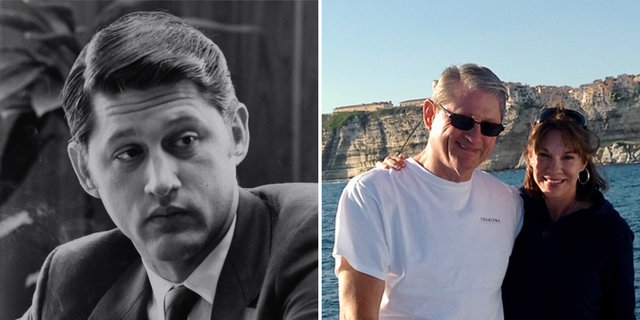
March 5, 2025
Former CEO Dick Davidson Recalls Living the ‘American Dream’ on the Railroad
“It’s been a helluva life. I’d never have believed you, if you told me 50 years ago this is how it would turn out,” he says in a telephone interview from Florida, where he and his wife, Trish, live when they’re not in Dallas. “It’s like the American Dream.”
Davidson’s story is a part of Union Pacific’s story. He and his team of railroaders played an instrumental role shaping the Union Pacific of today, negotiating successful mergers with Chicago & North Western and Southern Pacific in the 1990s to extend Union Pacific’s coverage in the Midwest, Pacific Northwest, and Texas and Louisiana.
Davidson, who came to Union Pacific as the result of a merger, was at the helm during some of those pivotal years.
EARLY YEARS
Davidson was 6 when his father died in a car accident. His mother worked as a nurse to support the family while Davidson and his brother handled the chores on the family farm near Allen, Kansas, pop. 200.
In 1960, Davidson was awarded a small scholarship to attend Washburn University in Topeka, Kansas. It wasn’t enough to cover all expenses and, as fate would have it, Missouri Pacific was hiring.
After passing an aptitude test, a back X-ray and going on trips with seasoned conductors, Davidson was hired as a brakeman. His first paycheck paid for a used pocket watch, a railroad requirement back in those days.
He worked on the railroad throughout college, picking up trips on weekends and holidays. After graduation, the trainmaster recommended Davidson for the railroad’s management training program.
Davidson didn’t need much convincing. “I was hooked on that first paycheck,” he said.
RAILROAD CAREER
Davidson’s early years as a manager on the railroad included many jobs and moves, starting in Shreveport, Louisiana, as assistant trainmaster. He was there about six months before being transferred to Fort Worth, Texas. This move would prove to be a major turning point in his career.
Davidson, along with his superintendent, was tasked with modernizing and rebuilding the Fort Worth yard. During the project, the superintendent suffered a serious medical setback, and Davidson was promoted to superintendent at a very young age. After successfully completing the task, he was transferred to serve as superintendent in Little Rock, Arkansas.
His next move was to assistant general manager in Kansas City. During this time, the company sent him to Harvard for the Professional Management Development program. He continued up the ranks and became vice president of operations at Missouri Pacific in 1976.
He was 36 years old.
In 1982, two years after the Staggers Rail Act of 1980, Union Pacific acquired Missouri Pacific, and Davidson became a Union Pacific employee.
Davidson spent the first few years after the merger in St. Louis as vice president of operations. In 1986, he moved to Omaha, working for then-CEO and legendary railroader John Kenefick as vice president of regional operations.
In 1991, Davidson was promoted to chairman and CEO of Union Pacific Railroad.
MERGERS
The passage of the Staggers Act, which deregulated railroads, sparked an era of mergers within the rail industry as railroads realized they needed to grow to survive. Or, to put it another way, they needed to improve services and become more efficient.
“The Staggers Act made it very clear the railroads that could provide the best service at the least cost would be the longtime winners,” Davidson said.
Kenefick oversaw Union Pacific’s first mergers after Staggers, starting in 1982 with the acquisition of Missouri Pacific and Western Pacific.
Davidson kept the ball rolling, acquiring Chicago & North Western in 1995. “It was a huge piece of business,” he said. “It only made sense we acquire it, since our trains already ran into Chicago. Now, they could keep on going without interchange.”
He also noted the merger provided Union Pacific with access to Wyoming coal fields.
In 1995, Union Pacific began negotiating for the merger of Southern Pacific. It was a huge acquisition, nearly doubling the size of Union Pacific and extending the railroad’s coverage to the West Coast and the South.
POST-SOUTHERN PACIFIC
Union Pacific’s acquisition of Southern Pacific in 1996 created the best franchise in North America but did not come without challenges. “We were faced with service and logistical issues that took time and the effort of both management and employees to remedy. In hindsight, I would have slowed down the integration,” Davidson said.
Although not a merger, Union Pacific also entered into a successful joint venture to acquire partial ownership in a Mexican railroad during this time.
In 1997, Davidson became chairman and CEO of Union Pacific Corporation, holding that position until his retirement in 2006.
During that time, he presided over the sale of non-core businesses previously acquired by the corporation, saving millions of dollars and allowing Union Pacific to focus on its core railroad business.
RETIREMENT
After retirement, Davidson traveled extensively for about 10 years with his wife, three adult children, seven grandchildren and friends. He toured the Mediterranean, survived a storm off the coast of Italy and explored the isolated coves of the Caribbean.
Today, he’s learning to take life a little easier. He reads, exercises, follows his favorite sports teams and keeps in touch with retired railroaders.
He doesn’t miss the phone calls in the middle of the night that come with working on a railroad, but he does miss the great people and putting his problem-solving skills to work.
“The greatest joy in my life as a railroader was figuring out better ways of doing things, making operations more efficient,” Davidson said. “The railroad was always good to me. Looking back, it really was the American Dream.”